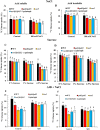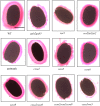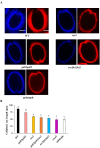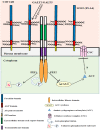Glycosylation of a Fasciclin-Like Arabinogalactan-Protein (SOS5) Mediates Root Growth and Seed Mucilage Adherence via a Cell Wall Receptor-Like Kinase (FEI1/FEI2) Pathway in Arabidopsis
- PMID: 26731606
- PMCID: PMC4701510
- DOI: 10.1371/journal.pone.0145092
Glycosylation of a Fasciclin-Like Arabinogalactan-Protein (SOS5) Mediates Root Growth and Seed Mucilage Adherence via a Cell Wall Receptor-Like Kinase (FEI1/FEI2) Pathway in Arabidopsis
Abstract
Fundamental processes that underpin plant growth and development depend crucially on the action and assembly of the cell wall, a dynamic structure that changes in response to both developmental and environmental cues. While much is known about cell wall structure and biosynthesis, much less is known about the functions of the individual wall components, particularly with respect to their potential roles in cellular signaling. Loss-of-function mutants of two arabinogalactan-protein (AGP)-specific galactosyltransferases namely, GALT2 and GALT5, confer pleiotropic growth and development phenotypes indicating the important contributions of carbohydrate moieties towards AGP function. Notably, galt2galt5 double mutants displayed impaired root growth and root tip swelling in response to salt, likely as a result of decreased cellulose synthesis. These mutants phenocopy a salt-overly sensitive mutant called sos5, which lacks a fasciclin-like AGP (SOS5/FLA4) as well as a fei1fei2 double mutant, which lacks two cell wall-associated leucine-rich repeat receptor-like kinases. Additionally, galt2gal5 as well as sos5 and fei2 showed reduced seed mucilage adherence. Quintuple galt2galt5sos5fei1fei2 mutants were produced and provided evidence that these genes act in a single, linear genetic pathway. Further genetic and biochemical analysis of the quintuple mutant demonstrated involvement of these genes with the interplay between cellulose biosynthesis and two plant growth regulators, ethylene and ABA, in modulating root cell wall integrity.
Conflict of interest statement
Figures











Similar articles
-
Two Hydroxyproline Galactosyltransferases, GALT5 and GALT2, Function in Arabinogalactan-Protein Glycosylation, Growth and Development in Arabidopsis.PLoS One. 2015 May 14;10(5):e0125624. doi: 10.1371/journal.pone.0125624. eCollection 2015. PLoS One. 2015. PMID: 25974423 Free PMC article.
-
Functional characterization of hydroxyproline-O-galactosyltransferases for Arabidopsis arabinogalactan-protein synthesis.BMC Plant Biol. 2021 Dec 13;21(1):590. doi: 10.1186/s12870-021-03362-2. BMC Plant Biol. 2021. PMID: 34903166 Free PMC article.
-
The FEI2-SOS5 pathway and CELLULOSE SYNTHASE 5 are required for cellulose biosynthesis in the Arabidopsis seed coat and affect pectin mucilage structure.Plant Signal Behav. 2012 Feb;7(2):285-8. doi: 10.4161/psb.18819. Epub 2012 Feb 1. Plant Signal Behav. 2012. PMID: 22353871 Free PMC article.
-
The FLA4-FEI Pathway: A Unique and Mysterious Signaling Module Related to Cell Wall Structure and Stress Signaling.Genes (Basel). 2021 Jan 22;12(2):145. doi: 10.3390/genes12020145. Genes (Basel). 2021. PMID: 33499195 Free PMC article. Review.
-
Sticking to cellulose: exploiting Arabidopsis seed coat mucilage to understand cellulose biosynthesis and cell wall polysaccharide interactions.New Phytol. 2017 May;214(3):959-966. doi: 10.1111/nph.14468. Epub 2017 Feb 13. New Phytol. 2017. PMID: 28191645 Review.
Cited by
-
Molecular Background of Pi Deficiency-Induced Root Hair Growth in Brassica carinata - A Fasciclin-Like Arabinogalactan Protein Is Involved.Front Plant Sci. 2018 Sep 19;9:1372. doi: 10.3389/fpls.2018.01372. eCollection 2018. Front Plant Sci. 2018. PMID: 30283481 Free PMC article.
-
The Regulation of Cellulose Biosynthesis in Plants.Plant Cell. 2019 Feb;31(2):282-296. doi: 10.1105/tpc.18.00760. Epub 2019 Jan 15. Plant Cell. 2019. PMID: 30647077 Free PMC article. Review.
-
Arabinogalactan Proteins: Focus on the Role in Cellulose Synthesis and Deposition during Plant Cell Wall Biogenesis.Int J Mol Sci. 2022 Jun 13;23(12):6578. doi: 10.3390/ijms23126578. Int J Mol Sci. 2022. PMID: 35743022 Free PMC article. Review.
-
The Spatio-Temporal Distribution of Cell Wall-Associated Glycoproteins During Wood Formation in Populus.Front Plant Sci. 2020 Dec 15;11:611607. doi: 10.3389/fpls.2020.611607. eCollection 2020. Front Plant Sci. 2020. PMID: 33381142 Free PMC article.
-
Sweet Modifications Modulate Plant Development.Biomolecules. 2021 May 18;11(5):756. doi: 10.3390/biom11050756. Biomolecules. 2021. PMID: 34070047 Free PMC article. Review.
References
-
- Boisson-Dernier A, Lituiev DS, Nestorova A, Franck CM, Thirugnanarajah S, Grossniklaus U (2013) ANXUR Receptor-Like Kinases Coordinate Cell Wall Integrity with Growth at the Pollen Tube Tip Via NADPH Oxidases. Nasrallah JB, ed. PLoS Biology 11: e1001719 10.1371/journal.pbio.1001719 - DOI - PMC - PubMed
-
- Somerville C, Bauer S, Brininstool G, Facette M, Hamann T, Milne J, et al. (2004) Toward a systems approach to understanding plant cell walls. Science 306: 2206–2211. - PubMed
Publication types
MeSH terms
Substances
LinkOut - more resources
Full Text Sources
Other Literature Sources
Molecular Biology Databases

